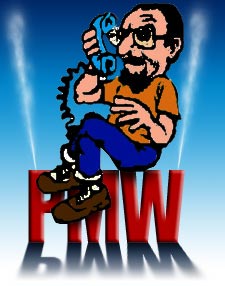|

6/6/03
|

Ed.
Note: Wady Hamam or Pro Mod
Wad as he is known in the sport as
drag racing's main nitrous Guru. He
has been involved in nitrous oxide
injection almost from its inception
especially with the Pro Mod division..
He is originally from the Buffalo,
New York area and has been involved
in all types of racing from flat track
motorcycles to fuel dragsters. In
his wasted youth he even raced a fuel
funny car powered by a blown and injected
small block Ford! He and his brother
campaigned a front motored Top Fuel
dragster and lost a race against Don
Garlits at the now closed Niagara
Falls Dragway. His advice about nitrous
problems is highly sought after but
he is hard to get to. He has agreed
to answer one question every couple
of weeks for Drag Racing Online readers.
Email your questions to: promodwad@racingnetsource.com,
and he will answer the question he
finds most intriguing.
(Original caricature Pete Millar) |
|
QUESTION
I have a 522 BB Chevy with a single carb and a plate system. I recently purchased an exhaust gas temperature gauge. What kind of temperature range should I be looking for the optimal mixture?
Secondly, can you shed some light on how to accurately read spark plugs? I have heard many stories and would like some clarification.
Thanks.
Cameron Stuart
ANSWER
Hi Cameron, The problem with exhaust gas
temperatur gauges on a nitrous engine is more
times than not the damage is done when you get
the temp. reading. Generally, exhaust temps
run between 1350 and 1500 degrees on a good
nitrous tune up, so it is hard to say what is
optimum.
As far as plug readings, the plugs will
look new with a slight grayish or tan-ish tint
on the porcelain when you have the right tune
up. They should not have any specks or aluminum
transfer on any part of the white. I would suggest
that you go to www.koehlerinjection.com
and bring up Nitrous Master. This site has great
info on tuning nitrous systems and reading plugs,
etc.
Thanks for the question.
Wady Hamam
Editor's Note:
As Wady suggested, Koehler Injection's Nitrous
Master has some great information about designing,
plumbing and using a nitrous system to best
advantage. We have decided to expand our pool
of tech experts and add Dave Koehler. Dave has
been a racer, machinist, engine and car builder,
and inventor for over 25 years. The past decade
he has turned his attention to nitrous oxide
injection and fuel systems. Next month he will
have his own Q&A column. To ask Dave a question
about fuel systems or related subjects, email
fuelforthought@racingnetsource.com.
By way of introduction, we asked Dave to
add his thoughts to the question above.
Cameron,
This is a common but fair question to which
there is no cut and dry answer. You will not
get two engines to feedback the same exhaust
gas temperature number. We have seen "perfect"
tune ups with 1100 degrees and we have seen
them with 1500+ degrees. In other words, your
buddies' numbers are useless to you.
ADVERTISEMENT
 |
The
problem lies with the placement of the egt probe
in the header, the type of probe being used
and the peculiarities of the engine itself.
Oh, and let's not forget that an over-rich condition
can lead to excess fuel burning in the pipes,
giving you a high temperature reading.
So... What to do?
I would tap all the header tubes and move
the probe around from tube to tube and find
your leanest cylinder. Start with the lean cylinder
and adjust your tune up by what your plugs are
showing you.
The caveat here is that if you are too rich
to begin with then your leanest (highest temp)
cylinder may be showing you burning fuel in
the pipes, so concentrate on the plugs first.
Assuming it is rich and you lean it out
in baby steps, you will want to recheck all
the cylinders from time to time to see if your
original lean cylinder is still the leanest.
Once you find the happy spot for the plugs
and the car is flying without needless damage,
then you will have found what the "optimum"
temperature is for your car on that particular
cylinder.
As to plug reading, it is too big a subject
to get into here. There is a whole chapter devoted
to plug reading in the Nitrous Master software
Tuning Files, with pictures that you will find
helpful. You can access it at www.nitrousmaster.com.
Have a safe race.
Dave Koehler
<
MORE STORIES >
|